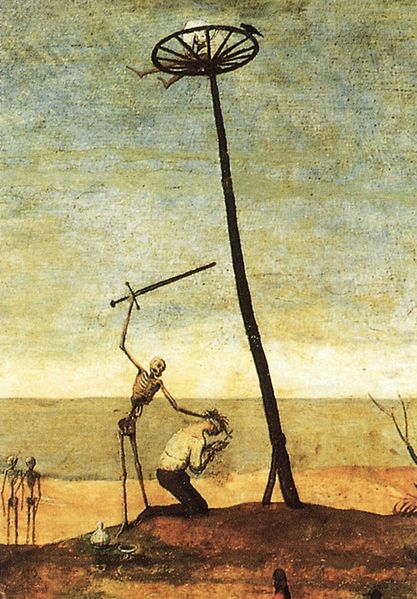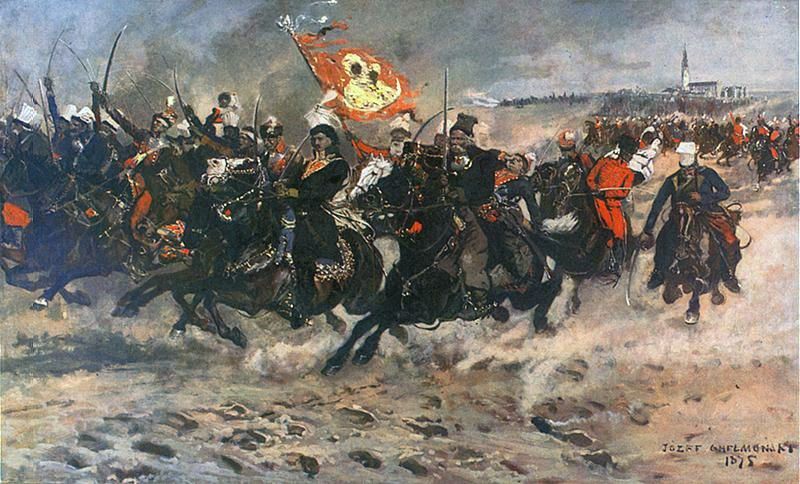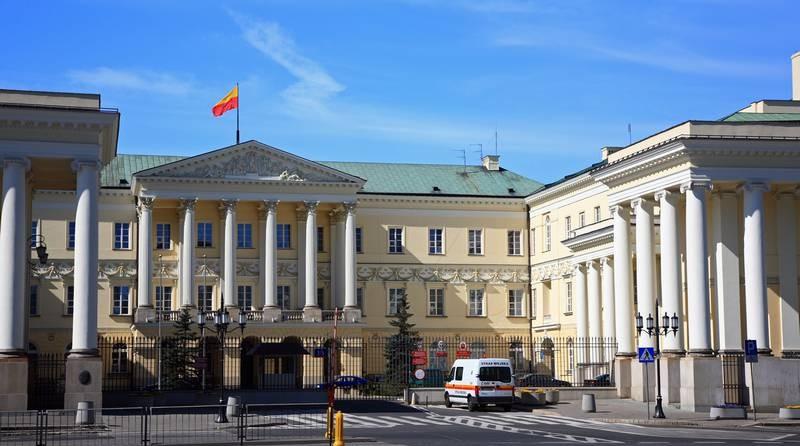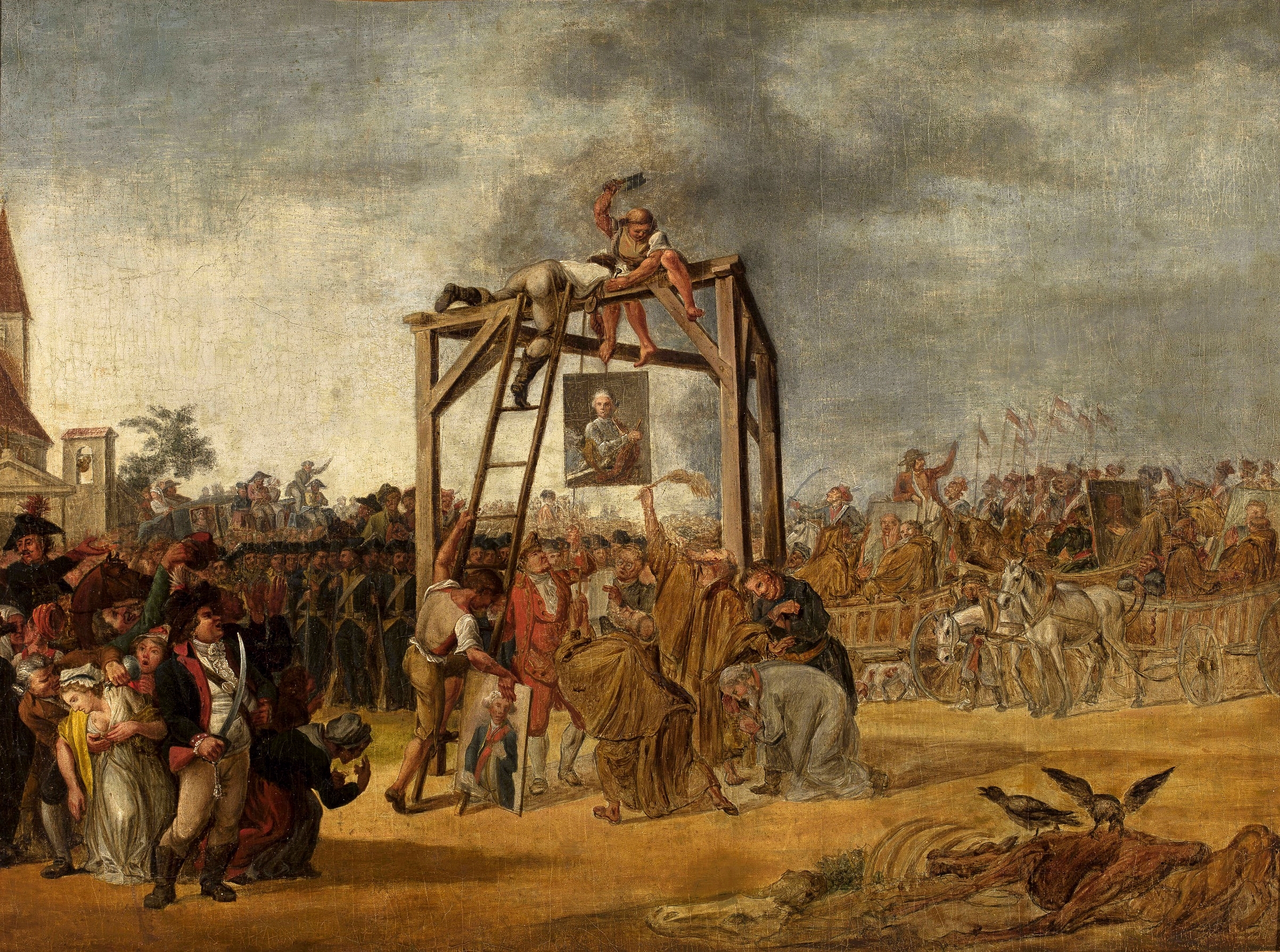|
Stefan Böhm (actor)
Stefan Böhm (other last name versions: Beym, Bem) (December 25, 1741 – February 26, 1813) was a Warsaw executioner. After leaving medical studies on University of Königsberg he became an official in Karol Stanisław "Panie Kochanku" Radziwiłł lands. Then he joined the Bar Confederation and was seriously injured in the head during a battle with Russian forces in Tyniec. He was saved and fled to Lidzbark Warmiński, where he lived with the local executioner, named Mueller, who taught him this profession. In 1793, after working as a supervisor over one of the bridges over the Bug River, Böhm was pressured by President of Warsaw Ignacy Wyssogota Zakrzewski to take a job as the Warsaw executioner, which post vacated after Jan Mueller, brother of Lidzbark executioner. Böhm was very popular among the Warsaw citizens. There was even a saying: ''you'll go and eat your breakfast at Stefanek's'', i.e. "you'll hang". Böhm carried out most of executions on Targowica Confederation lea ... [...More Info...] [...Related Items...] OR: [Wikipedia] [Google] [Baidu] |
Warsaw
Warsaw ( pl, Warszawa, ), officially the Capital City of Warsaw,, abbreviation: ''m.st. Warszawa'' is the capital and largest city of Poland. The metropolis stands on the River Vistula in east-central Poland, and its population is officially estimated at 1.86 million residents within a greater metropolitan area of 3.1 million residents, which makes Warsaw the 7th most-populous city in the European Union. The city area measures and comprises 18 districts, while the metropolitan area covers . Warsaw is an Alpha global city, a major cultural, political and economic hub, and the country's seat of government. Warsaw traces its origins to a small fishing town in Masovia. The city rose to prominence in the late 16th century, when Sigismund III decided to move the Polish capital and his royal court from Kraków. Warsaw served as the de facto capital of the Polish–Lithuanian Commonwealth until 1795, and subsequently as the seat of Napoleon's Duchy of Warsaw. Th ... [...More Info...] [...Related Items...] OR: [Wikipedia] [Google] [Baidu] |
Executioner
An executioner, also known as a hangman or headsman, is an official who executes a sentence of capital punishment on a legally condemned person. Scope and job The executioner was usually presented with a warrant authorising or ordering him to ''execute'' the sentence. The warrant protects the executioner from the charge of murder. Common terms for executioners derived from forms of capital punishment—though they often also performed other physical punishments—include hangman (hanging) and headsman (beheading). In the military, the role of executioner was performed by a soldier, such as the ''provost''. A common stereotype of an executioner is a hooded medieval or absolutist executioner. Symbolic or real, executioners were rarely hooded, and not robed in all black; hoods were only used if an executioner's identity and anonymity were to be preserved from the public. As Hilary Mantel noted in her 2018 Reith Lectures, "Why would an executioner wear a mask? Everybody k ... [...More Info...] [...Related Items...] OR: [Wikipedia] [Google] [Baidu] |
University Of Königsberg
The University of Königsberg (german: Albertus-Universität Königsberg) was the university of Königsberg in East Prussia. It was founded in 1544 as the world's second Protestant academy (after the University of Marburg) by Duke Albert of Prussia, and was commonly known as the Albertina. Following World War II, the city of Königsberg was transferred to the Soviet Union according to the 1945 Potsdam Agreement, and renamed Kaliningrad in 1946. The Albertina was closed and the remaining non-Lithuanian population either executed or expelled, by the terms of the Potsdam Agreement. Today, the Immanuel Kant Baltic Federal University in Kaliningrad claims to maintain the traditions of the Albertina. History Albert, former Grand Master of the Teutonic Knights and first Duke of Prussia since 1525, had purchased a piece of land behind Königsberg Cathedral on the Kneiphof island of the Pregel River from the Samland chapter, where he had an academic gymnasium (school) erected in 154 ... [...More Info...] [...Related Items...] OR: [Wikipedia] [Google] [Baidu] |
Karol Stanisław "Panie Kochanku" Radziwiłł
{{disambiguation, geo ...
Karol may refer to: Places * Karol, Gujarat, a village on Saurashtra peninsula in Gujarat, west India * Karol State, a former Rajput petty princely state with seat in the above town Film/TV *'' Karol: A Man Who Became Pope'', a 2005 miniseries *'' Karol: The Pope, The Man'', a 2006 miniseries Other uses *Karol (name) *King Karol, a New York City-based record store chain * ''Karol'', a short title of the movie biographies '' Karol: A Man Who Became Pope'' and '' Karol: The Pope, The Man'', based on the early life of Pope John Paul II See also *Carol (other) *Kalol (other) *Karoli (other) *Karoo (other) *Karow (other) Karow or Karów may refer to:: * Karow, Mecklenburg-Vorpommern, Germany * Karow, Saxony-Anhalt, Germany *Karow (Berlin), a district in the borough of Pankow in Berlin * Karów, Poland *Marty Karow (1904-1986), All-American college football player a ... [...More Info...] [...Related Items...] OR: [Wikipedia] [Google] [Baidu] |
Bar Confederation
The Bar Confederation ( pl, Konfederacja barska; 1768–1772) was an association of Polish nobles (szlachta) formed at the fortress of Bar in Podolia (now part of Ukraine) in 1768 to defend the internal and external independence of the Polish–Lithuanian Commonwealth against Russian influence and against King Stanislaus II Augustus with Polish reformers, who were attempting to limit the power of the Commonwealth's wealthy magnates. The founders of the Bar Confederation included the magnates Adam Stanisław Krasiński, Bishop of Kamieniec, Karol Stanisław Radziwiłł, Casimir Pulaski, his father and brothers and Michał Krasiński. Its creation led to a civil war and contributed to the First Partition of the Polish–Lithuanian Commonwealth. Maurice Benyovszky was the best known European Bar Confederation volunteer, supported by Roman Catholic France and Austria. Some historians consider the Bar Confederation the first Polish uprising. Background Abroad At the end ... [...More Info...] [...Related Items...] OR: [Wikipedia] [Google] [Baidu] |
Russia
Russia (, , ), or the Russian Federation, is a List of transcontinental countries, transcontinental country spanning Eastern Europe and North Asia, Northern Asia. It is the List of countries and dependencies by area, largest country in the world, with its internationally recognised territory covering , and encompassing one-eighth of Earth's inhabitable landmass. Russia extends across Time in Russia, eleven time zones and shares Borders of Russia, land boundaries with fourteen countries, more than List of countries and territories by land borders, any other country but China. It is the List of countries and dependencies by population, world's ninth-most populous country and List of European countries by population, Europe's most populous country, with a population of 146 million people. The country's capital and List of cities and towns in Russia by population, largest city is Moscow, the List of European cities by population within city limits, largest city entirely within E ... [...More Info...] [...Related Items...] OR: [Wikipedia] [Google] [Baidu] |
Tyniec
Tyniec is a historic village in Poland on the Vistula river, since 1973 a part of the city of Kraków (currently in the district of Dębniki). Tyniec is notable for its Benedictine abbey founded by King Casimir the Restorer in 1044. Etymology The name of the village comes from a Celtic language word "tyn", which means wall or fence, and which means that the history of Tyniec as a fortified settlement (see gord) dates back to pre- Slavic times. Geography Tyniec lies southwest of the centre of Kraków, on the right bank of the Vistula, among limestone Jurassic hills, called the Tyniec Hills, with the highest one being Wielogora (also called Guminek), above sea level. Furthermore, Tyniec has a Vistula canyon (called Tyniec Gate), a Skolczanka Nature Reserve (est. 1957), and a locally renowned water source, Zrodlo Swietojanskie, the only source of this kind in the city of Kraków. In ancient times the village was located along a merchant trade route from Kraków, via Oświęcim ... [...More Info...] [...Related Items...] OR: [Wikipedia] [Google] [Baidu] |
Lidzbark Warmiński
Lidzbark Warmiński (; german: Heilsberg, ), often shortened to Lidzbark, is a historical town located within the Warmian-Masurian Voivodeship, in northern Poland. It is the capital of Lidzbark County. Lidzbark Warmiński was once the capital of Warmia and formerly its largest town. Lidzbark itself was a religious and cultural center, for which it was known as the ''Pearl of Warmia''. For a long period of time it was under the control of the Warmian Bishops and it was also a major economic center, only resigning its importance to the nearby city of Braniewo. The Warmian Bishop's Castle is considered to be a great artistic and historical value in the world and has been recognised as a Historic Monument by the Polish government. History The town was originally a settlement of Old Prussians known as ''Lecbarg'' until being conquered in 1240 by the Teutonic Knights, who named it Heilsberg. In 1306 it became the seat for the Bishopric of Warmia, and remained the Prince-Bishop' ... [...More Info...] [...Related Items...] OR: [Wikipedia] [Google] [Baidu] |
Bug River
uk, Західний Буг be, Захо́дні Буг , name_etymology = , image = Wyszkow_Bug.jpg , image_size = 250 , image_caption = Bug River in the vicinity of Wyszków, Poland , map = Vistula river map.png , map_size = 250px , map_caption = Bug River through Ukraine, Belarus and Poland , pushpin_map = , pushpin_map_size = 250px , pushpin_map_caption= , subdivision_type1 = Country , subdivision_name1 = Poland, Belarus, Ukraine , subdivision_type2 = , subdivision_name2 = , subdivision_type3 = VoivodeshipVoblastOblast , subdivision_name3 = Podlaskie, Mazovian, Lublin, Brest, Lviv , subdivision_type4 = , subdivision_name4 = , subdivision_type5 = , subdivision_name5 = , length = , width_min = , width_avg = , width_max = , depth_min = , depth_avg = , depth_max = , discharge1_location= Se ... [...More Info...] [...Related Items...] OR: [Wikipedia] [Google] [Baidu] |
President Of Warsaw
The city mayor of Warsaw, or more literally the ''city president of Warsaw'' (the official title in Polish is ''"prezydent miasta stołecznego Warszawy"'', literal translation ''"president of the capital city of Warsaw"'') is the head of the executive of the capital of Poland. Overview The first city mayor of Warsaw was Jan Andrzej Menich (1695–1696). The municipal self-government existed in Warsaw until World War II and was restored in 1990 (during the communist times, the National City Council – ''Miejska Rada Narodowa'' – governed in Warsaw). Since 1990, the structure of city government has been modified several times. Between 1975 and 1990 the Warsaw city mayors simultaneously led the Warsaw Voivode. In the years 1990-1994, the city mayor of Warsaw was elected by the city council. Subsequently, a controversial reform was introduced, transforming the city in the years of 1994–1999 into a loose municipal union of several gminas, dominated by one of them, t ... [...More Info...] [...Related Items...] OR: [Wikipedia] [Google] [Baidu] |
Ignacy Wyssogota Zakrzewski
Ignacy Wyssogota Zakrzewski (1745–1802) was a notable Polish nobleman, politician, art collector, Freemason, and the Mayor of Warsaw during the last years of the Polish–Lithuanian Commonwealth, in 1792 and 1794. Biography Ignacy Wyssogota Zakrzewski was born in Stary Białcz (Greater Poland Voivodeship). He was deputy of Poznań for the Great Sejm and one of the co-authors of the reforms of treasury passed by the Sejm during the Constitution of 3 May. In 1791 he co-founded the Society of Friends of the Constitution, and was among the most notable supporters of the reforms passed by that act, along with Hugo Kołłątaj and Ignacy Potocki. In 1792 he became the Mayor of Warsaw, but was overthrown by the confederation of Targowica. After the outbreak of the Kościuszko's Insurrection and the Warsaw Uprising of 1794 he again held that post. Simultaneously, he held a number of important government posts during the war with Russia, among them he headed the Provisional Temporary ... [...More Info...] [...Related Items...] OR: [Wikipedia] [Google] [Baidu] |
Targowica Confederation
The Targowica Confederation ( pl, konfederacja targowicka, , lt, Targovicos konfederacija) was a Confederation (Poland), confederation established by Polish–Lithuanian Commonwealth, Polish and Lithuanian magnates on 27 April 1792, in Saint Petersburg, with the backing of the Russian Empress Catherine II of Russia, Catherine II. The confederation opposed the Constitution of 3 May 1791 and fought in the Polish–Russian War of 1792, which led to the Second Partition of Poland, Second and Third Partition of Poland, Third Partitions of Poland. History The Targowica confederation opposed the Constitution of 3 May 1791, which had been adopted by the Great Sejm, especially the provisions limiting the privileges of the nobility. The text of the founding act of the confederation was drafted by the Russian general Vasili Stepanovich Popov, Chief of Staff of Prince Grigori Alexandrovich Potemkin. Its purpose was proclaimed in the small town of Targowica and the Potocki's estate (now in H ... [...More Info...] [...Related Items...] OR: [Wikipedia] [Google] [Baidu] |





